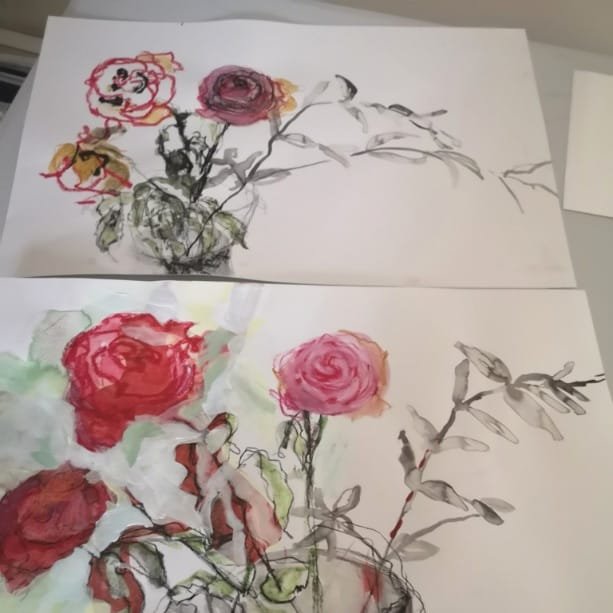How Breaking My Right Arm Helped My Art
In the fall, I signed up for a pre-recorded online art course and was looking forward to diving in as I had cancelled ALL other commitments. The brilliant Emily Ball Floribunda course took me on a journey exploring drawing and mark-making using not just my eyes but immersing in my sense of touch and smell and the delight of butterflying from one flower to the next – even drawing with my eyes closed and using my muscle memory to recall the forms and marks. A meditative way to explore new subject matter and to get deeper into the feeling and identify what it was that I actually wanted to capture in the piece.
This all took an unexpected turn as I suddenly fell, broke my wrist, and ended up with my right arm in plaster! If I wanted to continue, it was going to be by solely using my left, non-dominant hand. I felt an underlying sense of peace about it however and unusually optimistic. I had faith that God was watching over. After just two weeks here are some of my reflections.
New Brain Connections
It feels clunky and awkward and jerky. Why can’t I make a smooth mark? Years of using my right-hand means that my fine motor skills are way more developed in the opposite, left side of my brain. Now that I am forced into using my left-hand, the right side of my brain, being less developed with these skills, is called into action. So that means every time I am learning greater control with my left-hand new brain cells are developing. That’s got to be a win!
Working in Different Media
I know that it’s the feeling of these now dying roses that I want to capture rather than the precise details. If I choose a different media to draw with then I am sure that I can make smoother more fluid marks even with the clumsiness of drawing with my left hand. So instead of a normal pencil I switched to a fat oil pastel, some smudgy charcoal and some drawing ink. The results encouraged me on.FILL
How Did I Want My Work to “Feel”?
I was fearful of messing up previously started work on canvas which were looking at me from my studio wall. But how did I want my finished paintings to feel? In my preliminary work I had begun to explore the textures of the flowers – the softness, butteriness, spikey, bouncy, springy, crispy feelings of the petals and leaves. I was able to jump back into working on them with a clearer sense of purpose free from the constraints of observational accuracy by drawing with my left hand.
A Different Way of Seeing
How calm and peaceful it was working in this way and drawing with my left hand. Was this left-hand right brain connection something to do with it?
I listened to a TED talk, “My stoke of insight”, by the wonderful Jill Bolte Taylor who suffered a stroke in the left side of her brain and recounts her experience as a brain scientist. She retells how, without the left half of her brain she couldn’t walk, talk, or process information.
Each hemisphere of our brains processes differently. The right side is concerned with the present moment. It thinks in pictures and learns kinaesthetically through our body’s movements. Information streams in as an enormous collage as we discover what something looks like, smells like, feels like and sounds like. Our left brain however is concerned with the past and the future and thinks linearly. It loves details. It thinks in language and is the ongoing brain chatter that connects my internal world to my external world and reminds me of my to do lists. In using my right brain, I was tapping in to a different way of creating.
I am pleased to say that my arm seems to be mending well. I will however, be using my left-hand for a while yet and enjoying doing so. If you have never tried to draw with your non-dominant hand I suggest that you give it a go. It’s very liberating
Follow my progress more regularly on Instagram @gilldrewart where I post studio updates regularly.


